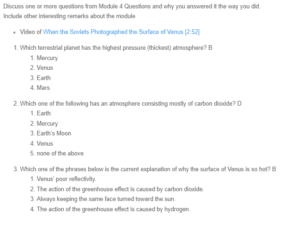The Solar System and its Components – Venus
Question 17
According to Seeds and Backman (2017), Venus, the second planet from the sun and the Earth’s planetary neighbour, has the thickest atmosphere. Venus’s thick atmosphere comprises greenhouse carbon dioxide and clouds of sulfuric acid. The thick atmosphere in Venus traps heat, making it feel extremely hot. Despite mercury being closest to the sun, it is not as hot as Venus, which retains substantive heat due to its thick atmosphere.
Question 18
Consistently, Venus has the largest concentration of carbon dioxide among the terrestrial planets. In composition, Venus’ atmosphere is roughly made up of 96% atmosphere, making it the planet with the most carbon dioxide concentration (Seeds & Backman, 2017). The other components found in Venus’s atmosphere include small amounts of sulfuric acid, some argon, and sulfur dioxide. Tiny amounts of water vapour, hydrochloric acid, and hydrofluoric acid are also present in the atmosphere (Seeds & Backman, 2017). These components make Venus to be unpleasantly deadly and quite unbreathable. The huge carbon dioxide concentration is the reason Venus cannot support human life since it is a stark difference from the carbon dioxide concentration found in the Earth’s atmosphere.
Question 19
Venus is also quite hot, with an atmospheric temperature of about 475 degrees Celsius (Seeds & Backman, 2017). These temperatures are enough to melt lead. Two factors explain the high temperatures in Venus’ atmosphere. First, Venus’ atmosphere is opaque to infrared radiation, which means that once sunlight filters through the clouds and melts the surface, heat cannot escape the surface (Seeds & Backman, 2017). Secondly, the high concentration of carbon dioxide on Venus escalates the severity of greenhouse gases, making Venus exhibit worse temperatures than Earth (Seeds & Backman, 2017). The high carbon dioxide concentration on Venus, which causes high heat levels, offers a glimpse of what the continued release of greenhouse gases may eventually do to the Earth’s surface.
Interesting Remarks about the Module
The module offers an understanding of the solar system and its components. Understanding all planets and the bodies surrounding the solar system helps determine how they have evolved. Also, studying different solar system elements plays a vital role in showing the impact of climate change on Earth. To that end, one of the main reasons why most planets do not support life is the high carbon dioxide concentration. Also, understanding the features of other planets helps geographers understand how different physical features on the Earth formed.
References
Seeds, M. A., & Backman, D. (2017). ASTRO 3. Cengage Learning.
ORDER A PLAGIARISM-FREE PAPER HERE
We’ll write everything from scratch
Question

The Solar System and its Components – Venus
Discuss one or more questions from Module 4 Questions and why you answered it the way you did.
Include other interesting remarks about the module
- Which terrestrial planet has the highest pressure (thickest) atmosphere? B
- Mercury
- Venus
- Earth
- Mars
- Which one of the following has an atmosphere consisting mostly of carbon dioxide? D
- Earth
- Mercury
- Earth’s Moon
- Venus
- none of the above
- Which one of the phrases below is the current explanation of why the surface of Venus is so hot? B
- Venus’ poor reflectivity.
- The action of the greenhouse effect is caused by carbon dioxide.
- Always keeping the same face turned toward the sun.
- The action of the greenhouse effect is caused by hydrogen.


